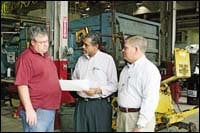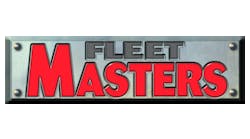Early in 2001, the City of Fort Worth Equipment Services Department (ESD) was in trouble. Customer service was poor, vehicle availability was low, and they were losing money. A consultant helped department managers write a detailed business plan tied to a newly developed set of objective performance measures.
Key statistics are pulled weekly from the city's fleet software to compile Weekly Performance Trends. The report presents data from across the department — fleet availability, percentage of scheduled preventive maintenance completed, spending on vendor service, labor utilization, parts expense, and internal revenue.
But Rudy Payton, CEM and assistant equipment services director, suggests that the daily version of these reports have had more influence on the turnaround.
"The Daily Status report tells us which vehicles are down, where they are, and the expected turnaround time to have each one back in production," Payton says. "Every morning, we get a capsule look at what the city fleet looks like and how the department performed the day before.
"In the past, we found that monthly or quarterly reports were too late to create the necessary actions to get back on track," Payton says. "This system is designed so that we can come up with alternative solutions to correct what might be inappropriate trends."
Information is a crucial tool for reviving the ESD, but it is just a tool. The real source of the recovery, Payton points out, is a major shift in motivation and capabilities in the shops.
"We were able to engineer a paradigm shift in accountability four years ago," Payton explains. "We changed from a culture where we were considered successful by our adherence to rules to a culture where every person, right down to the shop floor, is responsible and accountable for the organization's results."
The new mindset changed the department's employee appraisals, incorporating the new performance measurements.
"We rate technicians 1 to 5, with 5 being the best," Payton explains. "We have a lot of technicians rated at 4.0 or 4.5, which says they're good technicians. But four years ago, that didn't explain why our vehicle availability was 79 percent, and labor utilization was only 69 percent, or why we were over our labor budgets and parts budgets. So we had to ask: 'If everybody's superlative, why are our numbers in the toilet?'
"Obviously, we had to remove the subjectivity from our performance appraisals."
They adopted some guidelines based on standards developed by the National Association of Fleet Administrators (NAFA) and other industry organizations.
"Once a technician logs on to a work order, we know how much time that person used to perform the myriad tasks necessary to fix that vehicle," Payton says. And ESD managers audit a sample of work orders.
"If a technician logged on to a brake job on a police interceptor yesterday at 8 a.m. and off at 4 p.m., that dog just won't hunt," Payton says. "The next day his supervisor brings him in to talk about why it took seven hours to fix those brakes.
"We're not going to charge the customer for seven hours — we'll charge them for the reasonable time to do the job," Payton adds. "That mechanic is going to get some training, a counseling session, or a warning. And we carry this information over to his performance appraisal."
Pay to Improve
The system can be used to encourage technicians as well as to discipline them. It's a testament to wise application of the information that the City of Fort Worth's technicians continue to drive the department's success.
"One of the biggest positives of the daily and weekly reporting system is that each technician knows whether or not he turned in a good day's work that helped the department move toward its goals," Payton says. "We make the data available throughout the department, and individual people can see clearly and objectively how they are contributing to their group's performance.
"It has brought about some friendly competition between the shops, and generated a sense of pride in being part of the solution."
It's working. The target for fleet availability is 95 percent, and equipment in each of the major fleets — heavy equipment, water department, fire and police departments — exceeds that target by 1 to 2 percent.
"Seventy-four percent of light-vehicle work orders are complete in less than three days. Two years ago we were struggling to get 60 percent of them done," Payton says. "Seventy-seven percent of all work orders on medium/heavy vehicles are complete in five days or less. Almost 84 percent of off-road-equipment work orders are complete in seven days.
"One key performance index that we've looked at: In 2002, we processed a total of 58,000 work orders — last year we did 39,000," Payton says. "We're being more thorough on each work order and we're not having as many repeat repairs.
"The numbers reflect technicians becoming more proficient and taking more pride in what they do. We're seeing increases in the positive measures and decreases in negative numbers, with no change in the number of personnel."






